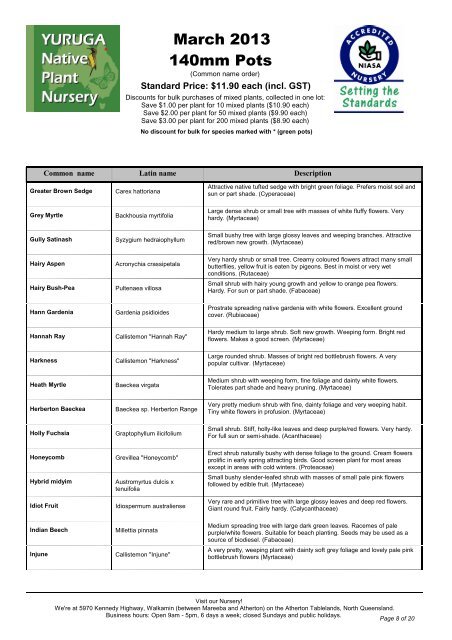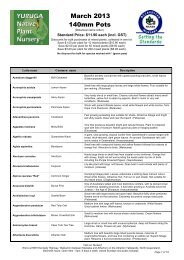in common name order - Yuruga Nursery
in common name order - Yuruga Nursery
in common name order - Yuruga Nursery
Create successful ePaper yourself
Turn your PDF publications into a flip-book with our unique Google optimized e-Paper software.
March 2013<br />
140mm Pots<br />
(Common <strong>name</strong> <strong>order</strong>)<br />
Standard Price: $11.90 each (<strong>in</strong>cl. GST)<br />
Discounts for bulk purchases of mixed plants, collected <strong>in</strong> one lot:<br />
Save $1.00 per plant for 10 mixed plants ($10.90 each)<br />
Save $2.00 per plant for 50 mixed plants ($9.90 each)<br />
Save $3.00 per plant for 200 mixed plants ($8.90 each)<br />
No discount for bulk for species marked with * (green pots)<br />
Common <strong>name</strong> Lat<strong>in</strong> <strong>name</strong><br />
Description<br />
Greater Brown Sedge<br />
Grey Myrtle<br />
Gully Sat<strong>in</strong>ash<br />
Hairy Aspen<br />
Hairy Bush-Pea<br />
Hann Gardenia<br />
Hannah Ray<br />
Harkness<br />
Heath Myrtle<br />
Herberton Baeckea<br />
Holly Fuchsia<br />
Honeycomb<br />
Hybrid midyim<br />
Idiot Fruit<br />
Indian Beech<br />
Injune<br />
Carex hattoriana<br />
Backhousia myrtifolia<br />
Syzygium hedraiophyllum<br />
Acronychia crassipetala<br />
Pultenaea villosa<br />
Gardenia psidioides<br />
Callistemon "Hannah Ray"<br />
Callistemon "Harkness"<br />
Baeckea virgata<br />
Baeckea sp. Herberton Range<br />
Graptophyllum ilicifolium<br />
Grevillea "Honeycomb"<br />
Austromyrtus dulcis x<br />
tenuifolia<br />
Idiospermum australiense<br />
Millettia p<strong>in</strong>nata<br />
Callistemon "Injune"<br />
Attractive native tufted sedge with bright green foliage. Prefers moist soil and<br />
sun or part shade. (Cyperaceae)<br />
Large dense shrub or small tree with masses of white fluffy flowers. Very<br />
hardy. (Myrtaceae)<br />
Small bushy tree with large glossy leaves and weep<strong>in</strong>g branches. Attractive<br />
red/brown new growth. (Myrtaceae)<br />
Very hardy shrub or small tree. Creamy coloured flowers attract many small<br />
butterflies, yellow fruit is eaten by pigeons. Best <strong>in</strong> moist or very wet<br />
conditions. (Rutaceae)<br />
Small shrub with hairy young growth and yellow to orange pea flowers.<br />
Hardy. For sun or part shade. (Fabaceae)<br />
Prostrate spread<strong>in</strong>g native gardenia with white flowers. Excellent ground<br />
cover. (Rubiaceae)<br />
Hardy medium to large shrub. Soft new growth. Weep<strong>in</strong>g form. Bright red<br />
flowers. Makes a good screen. (Myrtaceae)<br />
Large rounded shrub. Masses of bright red bottlebrush flowers. A very<br />
popular cultivar. (Myrtaceae)<br />
Medium shrub with weep<strong>in</strong>g form, f<strong>in</strong>e foliage and da<strong>in</strong>ty white flowers.<br />
Tolerates part shade and heavy prun<strong>in</strong>g. (Myrtaceae)<br />
Very pretty medium shrub with f<strong>in</strong>e, da<strong>in</strong>ty foliage and very weep<strong>in</strong>g habit.<br />
T<strong>in</strong>y white flowers <strong>in</strong> profusion. (Myrtaceae)<br />
Small shrub. Stiff, holly-like leaves and deep purple/red flowers. Very hardy.<br />
For full sun or semi-shade. (Acanthaceae)<br />
Erect shrub naturally bushy with dense foliage to the ground. Cream flowers<br />
prolific <strong>in</strong> early spr<strong>in</strong>g attract<strong>in</strong>g birds. Good screen plant for most areas<br />
except <strong>in</strong> areas with cold w<strong>in</strong>ters. (Proteaceae)<br />
Small bushy slender-leafed shrub with masses of small pale p<strong>in</strong>k flowers<br />
followed by edible fruit. (Myrtaceae)<br />
Very rare and primitive tree with large glossy leaves and deep red flowers.<br />
Giant round fruit. Fairly hardy. (Calycanthaceae)<br />
Medium spread<strong>in</strong>g tree with large dark green leaves. Racemes of pale<br />
purple/white flowers. Suitable for beach plant<strong>in</strong>g. Seeds may be used as a<br />
source of biodiesel. (Fabaceae)<br />
A very pretty, weep<strong>in</strong>g plant with da<strong>in</strong>ty soft grey foliage and lovely pale p<strong>in</strong>k<br />
bottlebrush flowers (Myrtaceae)<br />
Visit our <strong>Nursery</strong>!<br />
We're at 5970 Kennedy Highway, Walkam<strong>in</strong> (between Mareeba and Atherton) on the Atherton Tablelands, North Queensland.<br />
Bus<strong>in</strong>ess hours: Open 9am - 5pm, 6 days a week; closed Sundays and public holidays.<br />
Page 8 of 20



